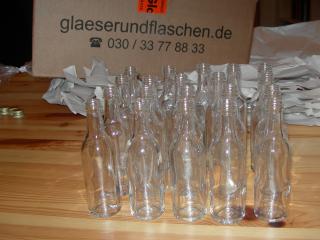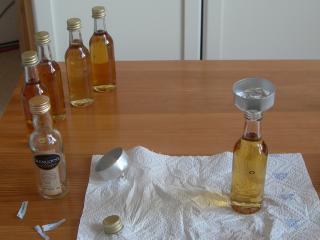I like to call myself a sceptic. Being sceptical also means to question your own senses: Does my HiFi gear really sound better since I connected the CD player and D/A converter using a gold cable, enabling the ones and zeroes to be somehow more digital? Or is it all just psychoacoustics, and the improvement only in my mind, because more expensive cables simply have to be better?
Once you've spent a lot of money, there are several motives to say something positive about the products you bought. First of all you may want to impress those who are not "in the know" or cannot afford the kind of stuff you are buying. But you may also want to avoid looking stupid in the circle of your friends when you admit to spending a lot of money for something that just isn't worth it. This is a very powerful motive that often works subconciously - you really believe that the goods carrying a higher price tag are better.
In October 2005, I vented my anger over self-styled connaisseurs who think that the most expensive goods are also the best in a Usenet newsgroup I was reading. It was about malt whisky in this case; one guy showered praise on a prohibitively expensive 21-year-old Single Malt, another dismissed Johnnie Walker. (For non-drinkers: Johnnie Walker whiskies are "Blends", mixtures of various malt whiskies and often also grain whiskies made from unmalted barley; "Single Malts" are whiskies from a single destillery. Single Malts are generally thought to be of a higher quality and are more expensive than blended whiskies.)
Another reader of the same newsgroup said that he was also of a sceptical nature but believed that, generally speaking, the older and thus more expensive whiskies tasted better than the cheaper ones (original posting, German). He would happily submit to a blind test.
Modalities were quickly agreed upon: I would select a number of whiskies available from German or UK retail stores and send him a tasting bottle of each; he would then try and order them according to his preference. The correlation of his ordering and that found in the marketplace - as expressed through the price tag - would show us whether he was right.
Of course neither my funds nor the taster's liver would allow for an experiment of any statistical signifiance, but a random sample would be fun enough.

Without further delay I ordered a few 5cl tasting bottles with screw caps on the Internet (at 0.60 € each). I needed a bit longer to make a selection of suitable whiskies. Using a range of Internet sources, I chose a wild cross-section of what the whisky world has to offer - starting at 10 € per litre for a supermarket "blend" and going all the way to the 20-year-old "Bruichladdich" single malt (150 €/litre).
All whisky prices in this article are given as price per litre. I calculated this number by using the price of the largest retail bottle (often 0.7l but sometimes 1.0l), converting it to price per litre and rounding it to the nearest 5 €.
In total, I selected three blends and 14 single malts (one of them from Ireland and this a whiskey, not a whisky). The single malts were aged between 7 and 21 years. Some of them were already in my possession, some I bought from local retailers and some from a relatively cheap German online store, whose downloadable PDF price list was also helpful in making my selection. For some exotic or very expensive whiskies, I only got a miniature bottle (containing 5cl).

I took delivery of the whiskies a week later, complete and with nothing to complain about (only the fact that some of the cardboard used for shipping seemed, according to the inscriptions, to have had a previous life as containers for Burger King meat patties caused a mild eyebrow movement).
In the mean time, another newsgroup participant had volunteered to help sponsor the experiment because he liked the idea. Even though the amount was rather symbolic, I was extremely happy about this. Boy, you could do a lot of interesting experiements if everyone was like that!
I created the final list, assigned each whisky a code letter, ran the tasting bottles through the dishwasher, marked them with letters and, after they had cooled and dried, began the "bottling process".

Lacking a proper funnel but at the same time not wanting to waste a drop of whisky (remember: in some cases I only had 5cl to begin with), I created makeshift funnels from aluminium tealight holders. I cleaned and boiled them before each use, just to be on the safe side - this was indeed the "bottle neck" of the whole experiment, and any mistake here could ruin it altoghether. (I tried to minimize exposure of the liquid to air, but of course could not eliminate this taste-changing potential altogether.)
This picture (a montage) shows all whiskies used in the test, along with the finished tasting bottles.

Once you have filled all the whiskies in identical bottles, you have a good view of the differences in colour (the order is not the same as in the photo above):

(At this point I have to tell you that even expensive whiskies are often coloured with spirit caramel; you cannot really deduce anything from a whisky's colour. There is a nice article (in German) about colours at The Whisky Store.)
The time had arrived: I had to say good-bye to the 17 bottles. I carefully boxed them and shipped it all off to the taster's address, about 150km away; he would now take all the time he needed to judge what was inside them.
A similar experiment with 56 participants was conducted in late 2006.